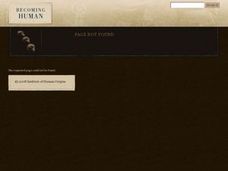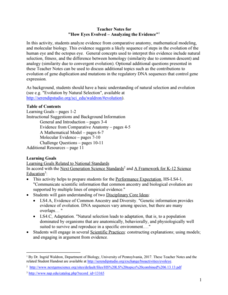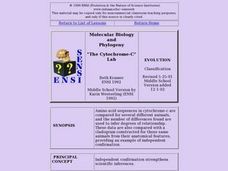Curated OER
Building Bodies
Young scholars identify key anatomical similarities and differences between great apes and humans. They infer likely anatomical features in ancient human ancestors and list principal anatomical changes in primates necessary for...
Whitman College
Virtual Fetal Pig Dissection
Pigs and humans have the same metabolism level and similar organs and systems, which is why they are often used in scientific laboratories. This worthy virtual dissection of a fetal pig divides into eight chapters: anatomical references,...
Curated OER
Muscles and Motor Locomotion
This is a fabulous presentation which should reinforce all aspects of muscle construction on a gross anatomical and micro level. There are slides to help understanding with the muscle fiber anatomy, and many labelled diagrams to explain...
Curated OER
Evidence of Change
Students identify evidence of change in species using fossils, anatomical similarities, and embryology. They identify homologous structures and arrange the steps of fossil formation. Students complete a group of selection of organisms...
Curated OER
Evidence of Evolution by Natural Selection
Walk your junior biologists through the evidence that supports evolution. The fossil record, anatomical record, and molecular record are explained and supported by colorful graphs and pictures. Extensive notes are provided for some of...
GP Strategies Corporation
Frog Dissection
One of the most common questions in a science classroom is, "Do we get to dissect anything?" With a fun and interactive experience, your eager biologists can perform a virtual dissection on a frog, as well as learn about different kinds...
Serendip
How Eyes Evolved – Analyzing the Evidence
Octopodes existed for hundreds of thousands of years before humans, yet our eyes share many similarities. Scholars analyze the evidence to determine if the evolution of eyes best fits a homology or analogy model. They discuss the issue...
Curated OER
Fish Anatomy
Students identify and interpret the internal anatomy of the fish. They also identify and define vocabulary for anatomical parts and anatomical functions and forms. Finally, students identify and interpret the differences in fish...
Curated OER
Clay Ants: Insect Anatomy
Students examine anatomic structures in order to identify insects from other living organisms. They gain a level of comfort from anxiety when observing and handling live and pinned insects. They create clay models of an insect.
Serendip
Evolution of Fur Color in Mice – Mutation, Environment and Natural Selection
Most species of animals include a variety of fur or hair color, but why? Scholars watch a video about a changing environment for mice. As the rocks around them change hues, different colors of mice begin to thrive. Discussion questions...
Curated OER
Animal Forms
Students demonstrate similarities and differences in animal forms, including humans.They investigate geometric relationships within those forms by building an animal using Zome System elements.
Curated OER
Sheep Brain Dissection
Young scholars study the brain and examine what the functions of the major functions are. In this investigative lesson students dissect a sheep's brain and note the similarities and differences between it and a humans brain.
Curated OER
Brine Shrimp Anatomy
Third graders investigate the anatomy of the brine shrimp. They construct a model of the shrimp to demonstrate the anatomical parts of the shrimp. Students research the different factors that contribute to shrimp survival. Then they...
Discovery Education
The Key to It All
Which characteristics make organisms unique? Dichotomous keys simplify the process of classifying organisms by focusing on these unique characteristics. Young scholars learn how to use the dichotomous key flow chart by creating their own...
Curated OER
Physiology of Reproduction
In this health worksheet, students examine the human body and make mental connections to the target function highlighted in the sheet.
Virginia Department of Education
Evidence of Evolution
What an impression fossils make! In this activity, aspiring paleontologists view fossils and construct a timeline to further understand how the lack of natural adaptation caused historical organisms to become extinct. While they should...
Curated OER
Cladograms and Genetics
For this genetics worksheet, students compare the human amino acid sequence with the five animals given. Students used cladograms to complete 11 short answer questions.
Curated OER
Designasaurus: Modeling Activity for a Paleoartist
Pupils create and draw fictional dinosaurs. They write a description of their dinosaur.
Curated OER
The Cytochrome-C Lab
Young scholars examine a method biologists use to try to determine relationships. They examine how amino acid sequences have been determined for a number of proteins, and how scientists can make inferences about DNA based on the amino...
Curated OER
Evidence for Evolution
In this evidence of evolution worksheet, students review notes given by referring to the Nelson Biology text, chapter 11/13. Students read the notes and the specified pages in the text.
Curated OER
Biological Concepts
Students perform a transection of a redworm. They discuss spinal cord injuries in humans. Students compare the ability of the redworm to regenerate the ventral nerve cord with the inability of humans to repair damage to the dorsal nerve...
Curated OER
Meeting an Earthworm
Students inspect the anatomy of earthworms. In this earthworm lesson, students participate in a hands-on experiment as they analyze the structure of earthworms. Students demonstrate mastery through differentiated products. Lesson...
Curated OER
Case Study Two: Shark Dissection
High schoolers read an article on sharks prior to beginning a dissection lab. As part of the lab, students identify differences between the shark anatomy and human anatomy and hypothesize why those differences exist.
Curated OER
Building a Body: Scale, Proportion, and Ratio
Students measure, analyze, and compare the ancient Egyptian canon of proportions using a mummy, painted images, and photographs of people today.

























